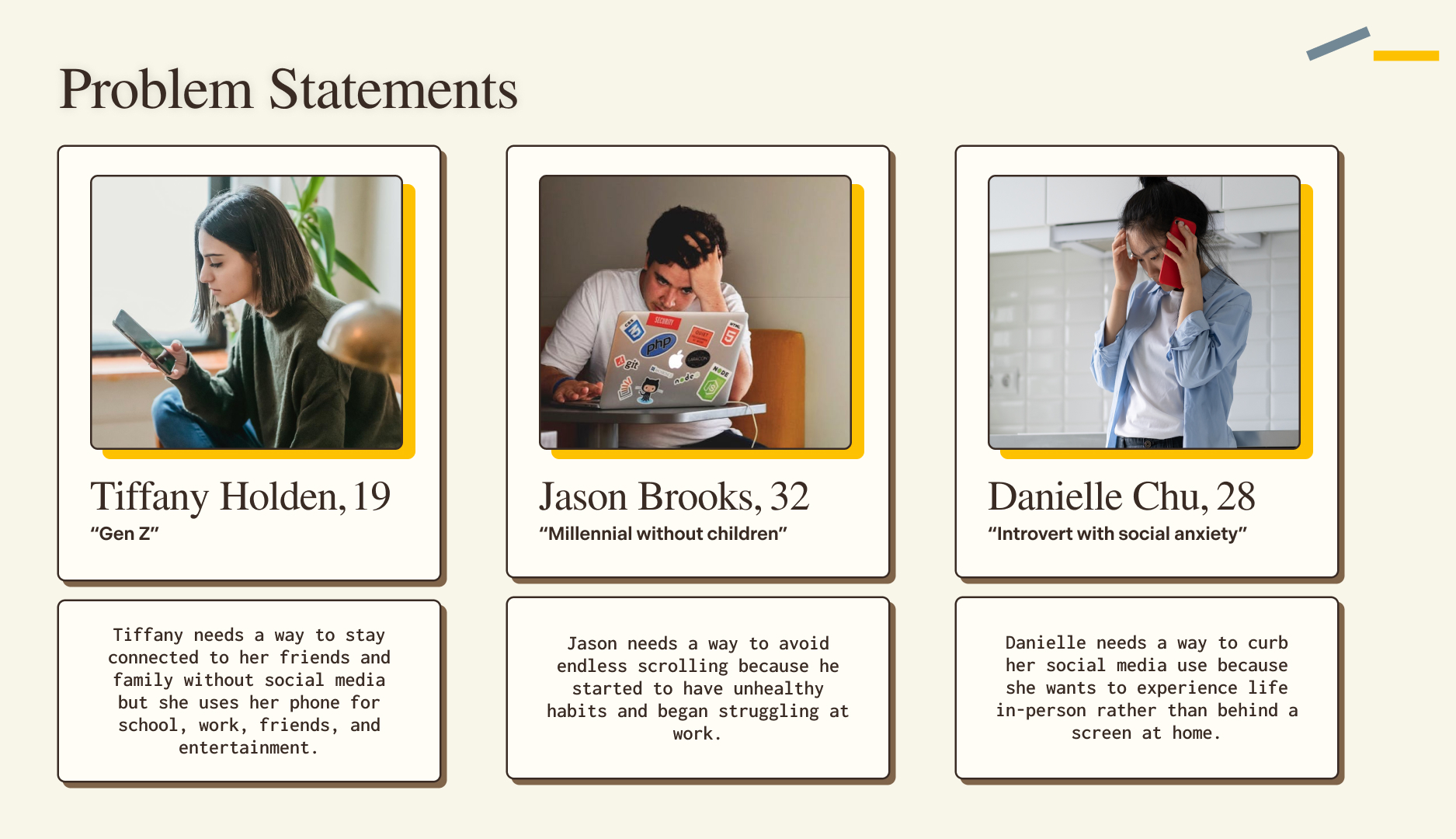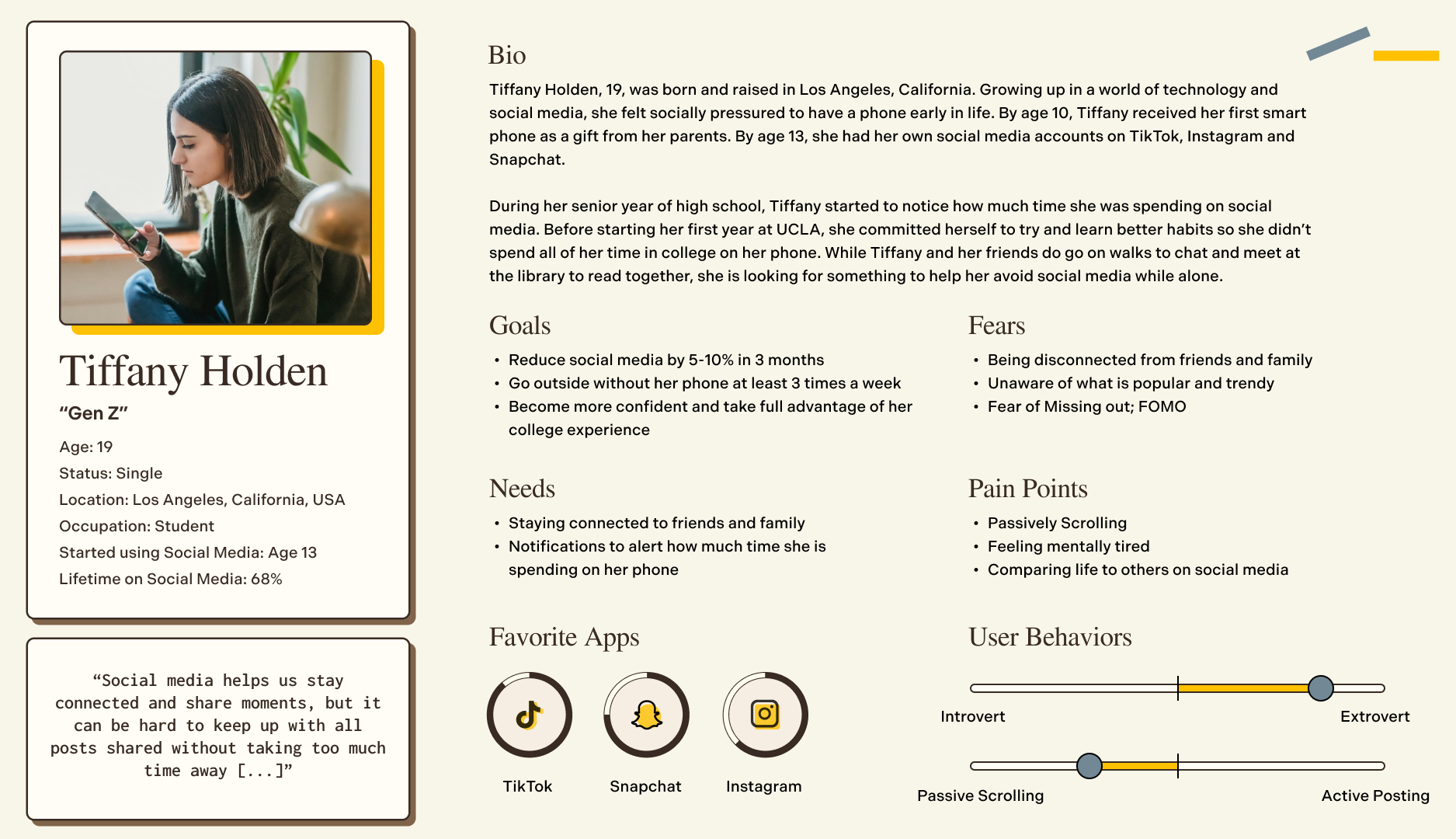Reclaim App
Course Project - Creating an alternative solution to social media addiction
Reclaim is an app designed to help individuals moderate their social media use while still maintaining their connection with friends and family. Using a combination of additional smartphone control features and naturally producing dopamine activities, Reclaim’s goal is to not cut out social media all-together, but to promote moderation and help users re-examine their relationship with technology.
View iOS Prototype
Year
2024
Timeline
4 Weeks
Role
UX Researcher, UX Designer, Visual Designer, Logo Designer
Tools
Figma, Figjam, Google Surveys
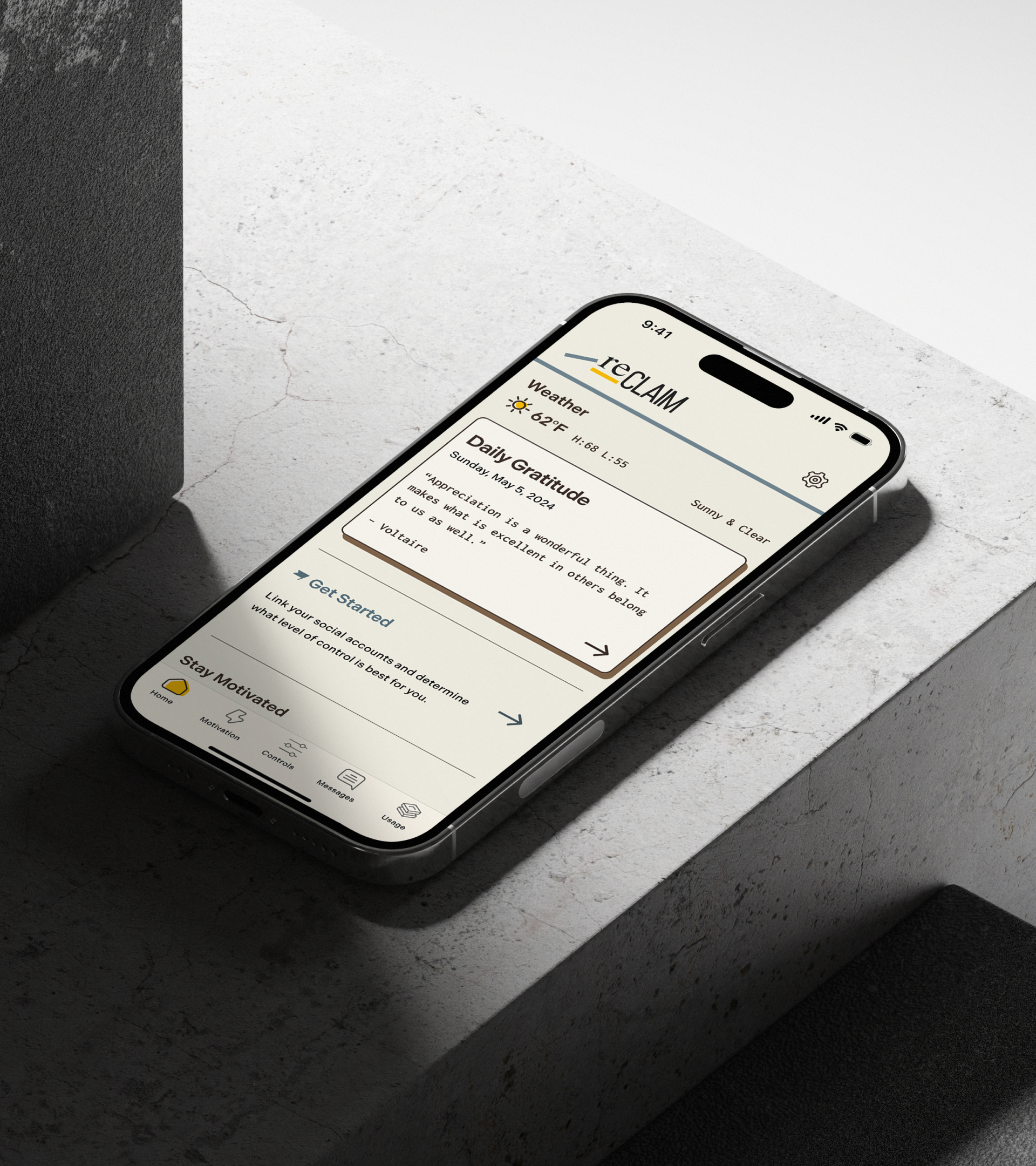
More Valuable Than Money
Observation
Social media companies today profit from people's time and attention through advertisement and online shopping.
Although there has been a huge effort for federal app regulations for minors across big tech companies in the U.S., adults (18+) are still solely responsible for their smartphone usage and susceptible to any addictive social media algorithms.
Curiosity
How do adults feel about social media and does it affect their health and well-being?
Tool or Crutch?
Initial Research
To further understand social media’s influence, I looked into existing research and articles to help ideate possible solutions. As a result, I was able to generate assumption personas and create a list of questions for both in-person interviews and an online user survey.
51
Survey Participants
In addition to 4 in-person interviews, I created a Google Survey of 61 questions to share on Reddit and reach a larger audience.
80.4%
Passively Scroll
According to Psychiatryonline, passive scrolling or mindless link jumping are riskier behaviors than actively posting (only 5.9% of participants).
62.7%
Check Their Phones
32 participants admitted to checking their phones more than 20 times a day, increasing their likelihood of passive scrolling or mindless link jumping.
18-24
Year Olds Want to Stop
18 to 24 year olds were the largest age group that tried to actively reduce the amount of time spent on social media. The second age group were 13 to 17 year olds.
Adults Need Help Too
Findings
When stress starts to overwhelm everyday life, adults begin to find extended refuge behind a screen. By using app limiters to try and reduce the amount of screen time, people unintentionally disconnect themselves from their loved ones–creating a friction point for those who use social media to stay in touch with friends and family. Ultimately, this leads to adults disabling the app limiters and opening the door to passive scrolling.
Potential Problems
Even though social media can provide a sense of human connection, especially for introverted personalities, passive scrolling or mindless link jumping can lead to impaired function of daily life such as diet and sleep, for a small subset of the population.
Project Goals
Helping Tiffany, Jason, and Danielle
Reduce the amount of screen time on social media apps by 10%.
Helping Tiffany and Danielle
Maintain a way of communication with family and friends.
Helping Jason and Danielle
Provide easily accessible alternatives for dopamine release rather than social media, especially when bored.
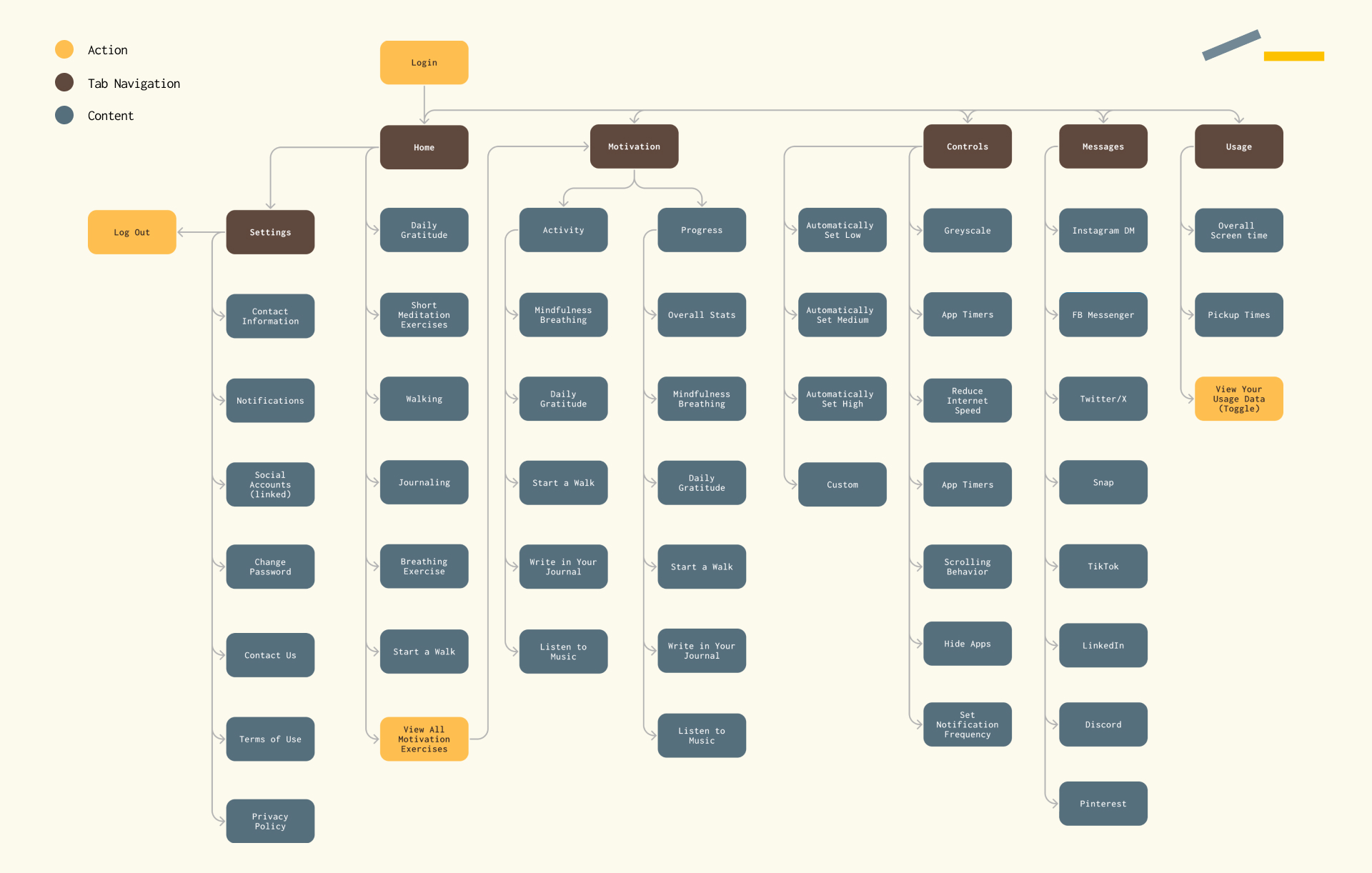
Tiffany Holden User Flow
Gen Z
Goal(s): Find a new way to communicate with family and friends that doesn't involve passive scrolling and mindless link clicking.
Task(s): Log into the Reclaim app as a returning user and adjust the restrictive level from 'medium' to 'custom'. Change the notifications from 'once an hour' to 'once every 4 hours'. Review daily and weekly stat pages.

Jason Brooks User Flow
Millenial without Children
Goal(s): Discover a healthier way to handle stress from work and to start exercising again.
Task(s): Log into the Reclaim app as a first-time user (FTU) by using an existing social accounts, e.g. Facebook, Google, Apple. Once completing the onboarding user flow, manually set the level to the highest restrictiveness. Increase the 'steps required to access social media accounts' from 'none' to '500'.

Danielle Chu User Flow
Introvert with Social Anxiety
Goal(s): To not rely on social media for a dopamine fix and slowly gather motivation to be more active in society.
Task(s): Log into the Reclaim app as a returning user and read the “Daily Gratitude” messages. Checks for new Messages. Go to the Reclaim homepage and start a short meditation exercise.

Iteration Through Testing
Mid-Fidelity Wireframes
With the help of 4 participants, I iterated on the Reclaim UI by conducting a moderated usertest via Zoom. Updates to the design were made to ensure Reclaim persona's user flows and goals were kept simple and streamlined.
Much Needed Simplicity
Logo & Visual Design
Counter intuitive to many social media app designs, Reclaim required a neutral color palette and simple visual hierarchy with minimal animations to not overstimulate the users. Taking some inspiration from Dieter Rams' work for Braun, the visual aesthetic landed in a mix of analog and digital.
Questions for Quick Use
Onboarding
As part of the Reclaim's onboarding experience, a skippable 7-question user flow is integrated to help users automatically apply customizable settings.
By responding to these questions, a customized pre-determined setting is applied at the end of onboarding with instructions to edit if the user wishes to customize any further.
Building New Habits
Interactive Activities
For individuals who actively use their phone to 'escape reality,' Reclaim provides 5 naturally dopamine producing activities to promote positive stimulation away from social media.
Activities such as 'Mindfulness Breathing' and 'Journal Writing' can boost mood and overall emotional well-being. These activities can be scalable by adding additional features to better help users achieve the goal of a healthy relationship with social media.
The Importance of Connection
Consolidated Messaging
By syncing social media apps with Reclaim, messaging can now be reallocated in one location. This provides the added reassurance for users who would like to stay connected without falling victim to mindless link jumping when on social media apps.
As an added disconnecting benefit, a user can control how often these messages are requested and updated on Reclaim.
Taking Back Control
Controls
For the extreme use cases, where users need extra deterrents from using social media, Reclaim provides additional controls that require actual physical movement.
One example is by using a smartphone's existing motion sensors and location services to set walking/step requirements.
Another additional control on Reclaim is 'Page Scrolling Speed', where overtime, as a user infinitely scrolls, it becomes harder to do so. In other words, it would respond slower per swipe.
Keeping an Eye On
Metrics
What does success look like for an app designed to help users stay off their smartphones?
1
Screen Time Decline
With users' approval, track social media consumption trends through Reclaim's "Usage" feature which pulls smartphone app activity from iOS.
Are users using Reclaim's messaging system over social media's messaging? Experiment with different methods of notifications to improve engagement to disengage.
2
Activity Use
Note which 'Motivational Activities' users are gravitating towards, i.e. monitor frequency of use, at what time of day, any phone use after Reclaim.
These findings can help prioritize new and existing features that users can really benefit from.
3
Customer Satisfaction
Look at product stickiness rate and customer retention YoY to examine Reclaim's value to users. Create a relationship by allowing users a way to contribute suggestions to make Reclaim better and useful for everyone.
4
Adoption Rate
Gauge the overall success of Reclaim by focusing on new users becoming returning users at 70%-90% adoption rate.
Credits
Institution
San Diego City College
Year
Spring 2024
Course
Interaction Design II
Professor
Leanna Jones


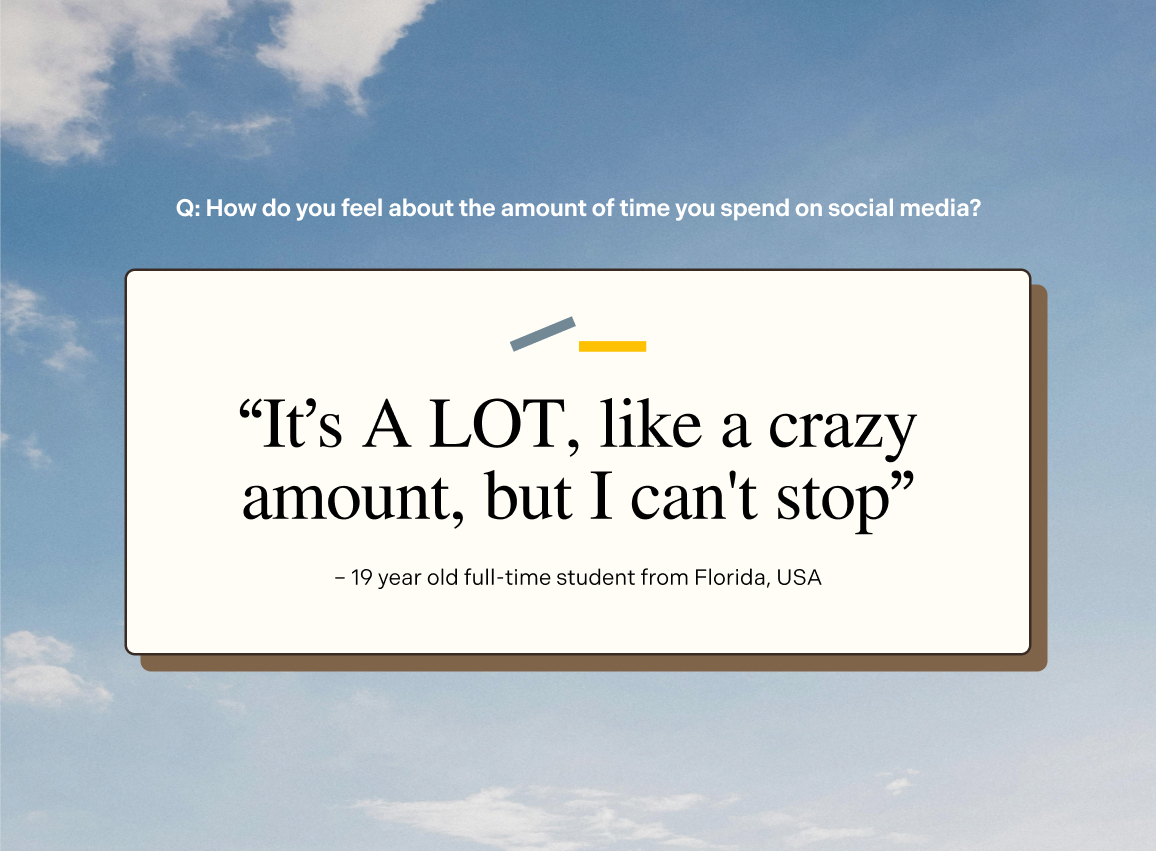
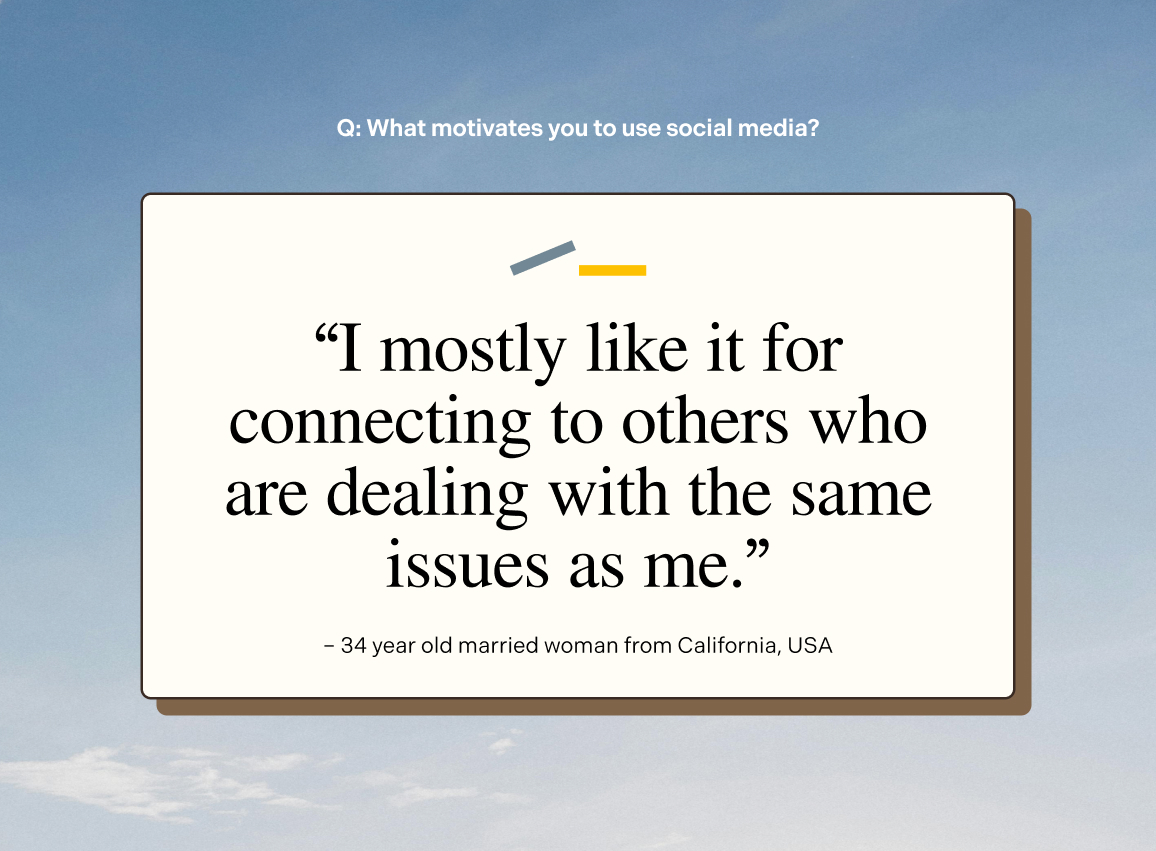
![Quote from survey participant. Have you ever tried to reduce your social media use? If so, what strategies did you use? Yes, I put screen timers on Instagram. It didn't work as I often use [Instagram] for messaging so preventing scrolling also prevented seeing important messages.](images/reclaim/quotes/Reclaim Quote 3.jpg)
![Quote from survey participant. How do you feel about the amount of time you spend on social media? “I would rather spend [my time on social media] doing other things, but most of the things I really care about make me super anxious.](images/reclaim/quotes/Reclaim Quote 4.jpg)
